Ayodhya Tourism
It's time to plan to explore the top rising religious destination of India: Ayodhya Ram Lala Tour.
It's time to plan to explore the top rising religious destination of India: Ayodhya Ram Lala Tour.

Ayodhya, the holiest place for Hindus in India, is the birthplace of Lord Ram, and the city is also considered among the top seven sacred places in India. Ayodhya, a heart throbbing city of Uttar Pradesh which carries tales of ancient history, mythology, and Nawabi culture. Ayodhya is located near the banks of the Sarayu River and this beautiful pilgrimage destination was historically known as Saketa. The city of Ayodhya is a combination of beautiful historical buildings, stunning museums, blissful temples and magnificent gardens
The textbooks of Buddhists and Jains also mention that their religious leader,Gautam Buddha and Mahavira visited and lived in this city. They also believehat it was the birthplace of five Tirthankaras namely, Rishabhanatha,jitanatha, Abhinandananatha, Sumatinath and Anantnath.
According to the holy book of Ramayana, the ancient city of Ayodhya is where the Hindu deity Lord Rama was born. It is therefore, at his birthplace where today stands the Shree Ram Janmabhoomi Mandir at Ayodhya. Dedicated to Lord Rama, the temple holds immense religious significance among Hindu devotees. The construction of the Shree Ram Janmabhoomi Temple at Ayodhya was started by laying the ceremonial foundation stone on 5th August 2020 by the Prime Minister of India, Narendra Modi. After years of dedicated work, the Shree Ram Janmabhoomi Mandir now stands as the pride of Ayodhya. The temple has been built following the Nagara style of temple architecture and has now become one of the top pilgrimage destinations among Hindus in India and abroad. Now open to devotees, the temple opened its door for worship after the Pran Pratistha ceremony on 22nd January 2024 and worships Lord Rama in his younger form of the Ram Lalla.
Tourism in Ayodhya has been heavily influenced over the last few years especially after the construction of Ram Mandir. Ayodhya being Lord Ram's birthplace is a popular tourist attraction in India as it attracts tourists from all over the world. Devotees visit Ayodhya to receive blessings from Lord Rama.
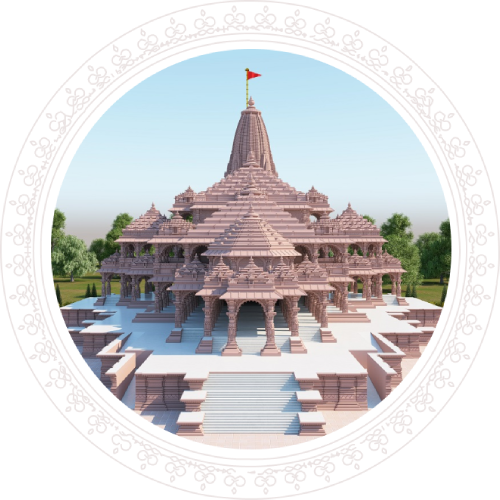
The most beautiful points of interest and places to explore near Ayodhya include the Ram Lala
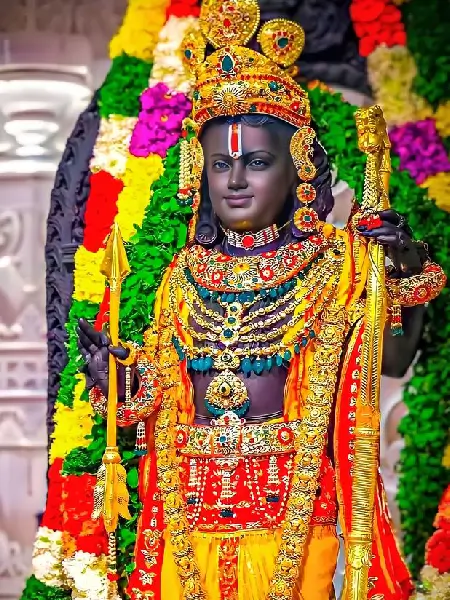
Reincarnated as the seventh avatarofVishnu, Lord Rama isthe character around which the holy book of Ramayana revolves around. An importantfigure in Hinduism, he is worshiped and adored for more than just his divine abilities.As per mythology, Lord Rama is considered to be the most human avatar of Lord Vishnu and is remembered and appreciated for his loyalty, kindness and most importantly filial piety. Reading about the stories about Lord Rama, there is much that a common person can learn from. Although born into a royal family, he has always managed to walk in humility and compassion.
Born into the Kosala Kingdom of Ayodhya, Lord Rama was the son of King Dasharatha and his wife Queen Kaushalya. Eldest of the four sons of the King, Lord Rama had three step brothers namely, Lakshmana, Bharata, and Shatrughna. A rightful owner to the throne, Lord Rama was the crown prince of the Kingdom of Kosala. Scared to lose her position in the kingdom, Queen Kaikeyi, the mother of Bharata conspires to send Lord Rama in exile for 14 years and asks for her son to be crowned instead. Bound by a promise given to the Queen years ago, the King finds himself unable to refuse her wish. It is here that we discover the filial piety of Lord Rama towards his father, who without a quarrel simply chooses to obey the orders of the King.
Check out our well-designed and meticulously planned Ayodhya tour packages and get the best holiday deals when booking with us. Fill out the enquiry form for more details.
As a popular religious tourism destination in Uttar Pradesh, Ayodhya has decent staying facilities for tourists, ranging from budget to luxury.
While visiting Ayodhya, the birthplace of Lord Rama, one can visit several other holy towns of the nation which carry a huge significance in the heart of Hindus and are widely recognised for their historical relevance are stated below.
Ayodhya is well connected with all the major cities of the nation. One can take a train, flight, car or bus to reach the holy city of Ayodhya. Here is how to reach Ayodhya:

The nearest airport in Ayodhya is Maharishi Valmiki International Airport which is only 5 kilometres away from the Ayodhya Dham. People can also get off at Chaudhary Charan Singh International Airport in Lucknow or Prayagraj Airport. Tourists can easily hire a cab or any suitable transport to visit the required location.

The city of Ayodhya is well connected to the major cities by railways. To visit the holy town of Ayodhya, get off at Pandit Din Dayal Upadhyay Junction or one can also get off at Ayodhya Junction and Ayodhya Cantt railway station. A special train is also available to the travellers that run from Delhi to the main sites of Ramayana Circuit, Ramayana Circuit Train.

Reaching Ayodhya by road is quite flexible as the road connects to the major cities and towns of India which include Lucknow, Kanpur, Gorakhpur, Prayagraj, Varanasi and Delhi. Direct bus routes connect the city to all major cities. One can either visit the city by hiring a cab or also use privatevehicles. A direct bus service has also been started between Ayodhya and Janakpur, in Nepal as a part of the Ramayana circuit.
Some best places to visit in Ayodhya include Ram Janmabhoomi, Kanak Bhawan, Hanuman and several other sightseeing landmarks. Visiting these attractions in the months of winter is ideal as the weather is quite pleasant at that time. Although one can visit Ayodhya at any time of the year.
In Ayodhya, summer stays from the months of April to June whenthe temperature increases from 28 degrees Celsius to 45 degreesCelsius. It is therefore advisable to avoid visiting hesightseeing options although one can still visit if one wishesto.
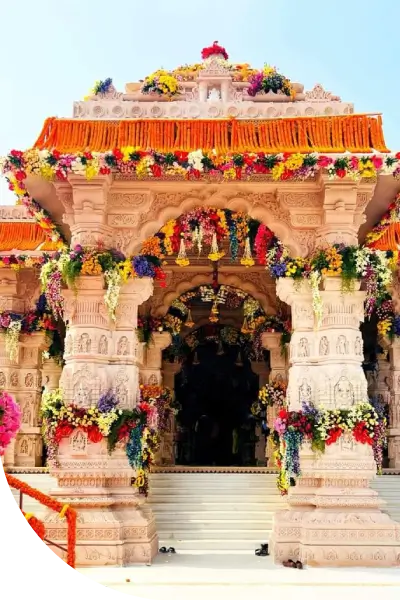
Monsoon stays here from July to September where the temperature ranges from 24 degrees Celsius to 32 degrees Celsius. It is advisable to avoid visiting Ayodhya as the heavy rains might affect the sightseeing plans of tourists.

Winter in Ayodhya stays from the months of October to March. The temperature ranges from 5 degrees Celsius to 27 degrees Celsius. This season is said to be the peak season for Ayodhya tourism.

In Ayodhya, summer stays from the months of April to June when the temperature increases from 28 degrees Celsius to 45 degrees Celsius. It is therefore advisable to avoid visiting the sightseeing options although one canstill visit if one wishes to.

Monsoon stays here from July to September where the temperature ranges from 24 degrees Celsius to 32 degrees Celsius. It is advisable to avoid visiting Ayodhya as the heavy rains might affect the sightseeing plans of tourists.
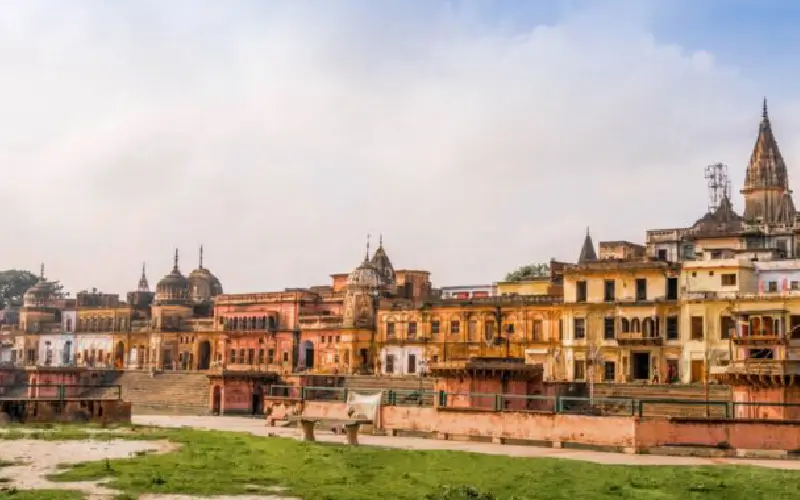
Winter in Ayodhya stays from the months of October to March. The temperature ranges from 5 degrees Celsius to 27 degrees Celsius. This season is said to be the peak season for Ayodhya tourism.
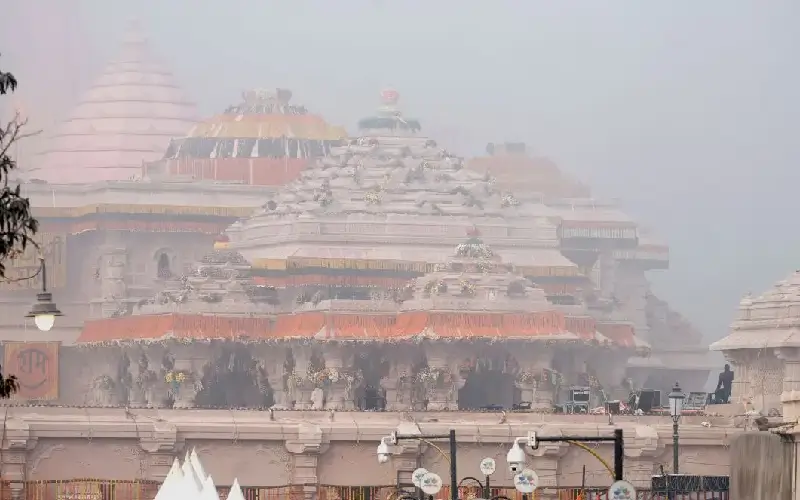

Some frequently asked questions about Ayodhya sightseeing tour packages.
Get the Best Deals on Ayodhya Holiday Packages. Request for free quotes. adipiscing.
Ayodhya is famous for being the birthplace of Lord Rama, the incarnation of Lord Vishnu, and makes this an important pilgrimage destination among Hindus.
The top tourist attractions to visit in Ayodhya include
Ayodhya can be visited throughout the year as the surge of tourists can be seen during the peak season which lies between the months of October to March. The weather during the season is pleasant and colder.
Ayodhya, the birth place of Lord Rama in Uttar Pradesh is a religious centre that is a combination of beautiful historical buildings, stunning museums, blissful temples and magnificent gardens. Every year, millions of pilgrims visit Ayodhya in search of peace and enlightenment, to feel connected to Lord Rama. Lord Rama signifies a figure of a loyal son, ideal husband, caring brother and also an excellent example for his adherence to Dharma. For Hindus, this city is considered among the top seven sacred places as it caters to the religious people in India among other things as well.
Today, at the site of Lord Rama's birthplace stands the glorious Shri Ram Janmbhoomi Mandir. Worshiping Lord Rama, the temple houses the mesmerizing idol of Ram Lalla, the child form of the lord. Adorned with elaborate jewelry and offerings of common toys made of silver, the idol of Ram Lalla inside the temple is said to represent the five-year old form of Lord Rama. Ever since the Pran Prathishtha that took place at Ayodhya's Ram Mandir, the temple has opened its door for devotees. When visiting the temple now, you can witness the glory of Ram Lalla for yourself as he sits peacefully in the temple's sanctum sanctorum.
Read along this travel guide to Ayodhya's Ram Mandir to know everything about the temple that will make your tour to the city a fruitful one. In this guide, you will find information about the history and architecture of the temple, aarti and darshan timings, along with how you can reach the temple and other religious places to explore in Ayodhya along with the temple.
Established at the site of the birthplace of Lord Rama, the Shri Ram Janmabhoomi Temple at Ayodhya goes way back in time. Although the present structure began its construction in 2020, the temple has its roots centuries back. It is built at the site of an earlier existing temple, believed to have been razed down by foreign invaders. After years of legal disputes, the site of the present-day Ram Mandir was handed over to the Shri Ram Janmabhoomi Teerth Kshetra Trust who oversaw its construction in 2020. It was then, on January 22, 2024 that the temple was inaugurated with a Pran Prathistha and has since then remained open to the devotees.
The Shri Ram Janmabhoomi Mandir at Ayodhya can be understood as a grand and majestic temple for anyone looking at it, because it truly is so. Built in the Nagara style of temple architecture, the temple covers an area of 2.7 acres and is three storeys tall. With no amount of steel or iron used during its construction, the main materials used to build the temple include Rajasthan's Pink Sandstone from Bansi Paharpur and the beautiful Makrana Marble, which is said to increase the temple's durability for thousands of years.
Featuring 392 intricately sculpted pillars depicting different Hindu gods and goddesses, Ram Mandir stands tall at a height of 161 ft. and features a total of five mandapas namely, the Nritya Mandap, Rang Mandap, Sabha Mandap, Prathana Mandap and Kirtan Mandap. The temple can be entered through the Singh Dwar after covering a flight of 32 stairs, with arrangements of special provisions for the elderly and the differently abled also being made available. With the main temple dedicated to Lord Rama, there are smaller shrines established along the four corners of the temple as well that worship Lord Surya, Goddess Bhagwati, Lord Ganesha, and Lord Shiva.
The main deity of Ayodhya's Ram Mandir is Lord Rama, considered the seventh incarnation of Lord Vishnu. At the Shri Ram Janmabhoomi Mandir, Lord Rama is worshiped in the form of Ram Lalla, a younger, five-year old form of the lord. Within the temple, Ram Lala sits inside the garbhagriha where he is available to be viewed by devotees.
In the temple's garbhagriha there are now two idols of Ram Lalla. The first one is an older idol of Ram Lala that was worshiped in a nearby tent for decades, before the establishment of the current temple. The second Ram Lalla idol is the newer one that has been sculpted by Arun Yogiraj from Mysore, and measures 51 inches in height.
Carved out of black stone, Ram Lalla sits adorning elaborate gold jewelry, with each of them chosen after extensive research about the appearance and grandeur of Lord Rama and includes the following:
Ever since the Pran Prathishtha of the Ram Mandir, the temple has been opened up for devotees for darshan. The timings for the darshan are mentioned as follows:
| Slot | Timings |
|---|---|
| Morning | 06:00 AM to 12:30 PM |
| Evening | 01:30 PM to 10:00 PM |
Given that Lord Rama is worshiped at the temple in his younger form of Ram Lalla, the temple remains closed in the afternoon hours between 12:30 PM to 01:30 PM to allow the deity to rest
During the day, there are a number of aartis that take place to worship the idol of Ram Lalla, the timings for which are mentioned below:
| Aarti | Timings |
|---|---|
| Mangala Aarti | 04:30 AM |
| Shringar Aarti | 06:30 AM |
| Bhog Aarti | 12:00 AM |
| Madhyana Aarti | 02:30 pm |
| Sandhya Aarti | 07:30 PM |
| Shayana Aarti | 10:00 PM |
Getting to attend an aarti at the Shri Ram Janmabhoomi Temple is bound to be a one of a kind experience, hence it is important that you acquire all the essential information you need to witness it. There are multiple types of aartis that take place at Ram Mandir and are categorized as Mangala Aarti, Shringar Aarti, Bhog Aarti, Madhyana Aarti, Sandhya Aarti, and Shayana Aarti, among which devotees can partake only in the Mangala Aarti, Shringar Aarti, and the Shayana Aarti only. Devotees who wish to attend an aarti at the temple must obtain a pass which they can do so either by visiting the temple themselves or applying for it in online mode, details of which are mentioned further.
The closest railway station to the temple is the Ayodhya Dham Junction Railway Station located at a distance of approximately 1 km and the Faizabad Railway Station at a distance of 11 km. The station has trains running frequently to different parts of the country such as Delhi, Amritsar, Ahmedabad, Mumbai, among others and have been mentioned as follows:
| City | Airlines |
|---|---|
| Delhi | Air India Express, IndiGo, Akasa Air, SpiceJet |
| Mumbai | IndiGo, SpiceJet |
| Bengaluru | Air India Express, SpiceJet |
| Ahmedabad | SpiceJet, IndiGo |
| Kolkata | Air India Express |
| Chennai | SpiceJet |
| Jaipur | SpiceJet |
| Patna | SpiceJet |
| Pune | Akasa Air |
| Air India Express | SpiceJet |
| Darbhanga | SpiceJet |
The nearest airport to the Shri Ram Janmabhoomi Mandir is the Maharishi Valmiki International Airport, located at a distance of 11 km from the temple. The airport operates flights from different cities of the country to the city of Ayodhya, details of which are as follows:
| City | Train | Running Days |
|---|---|---|
| Delhi | Vande Bharat Express | Monday, Tuesday, Thursday, Friday, Saturday, Sunday |
| Delhi | Ayodhya Express | Daily |
| Delhi | Kaifiyat Express | Daily |
| Amritsar | Saryu Yamuna Express | Monday, Wednesday, Saturday |
| Ahmedabad | Sabarmati Express | Monday, Tuesday, Thursday, Saturday |
| Jaipur | Marudhar Express | Monday, Thursday, Saturday |
| Jodhpur | Marudhar Express | Monday, Thursday, Saturday |
| Bhopal | Yesvantpur-Gorakhpur Express | Saturday |
| Indore | Indore-Patna Express | Saturday |
| Mumbai | Mumbai Saket SF Express | Wednesday, Saturday |
| Kolkata | Kolkata-Jammu Tawi Express | Daily |
| Jammu | Jammu Tawi-Kolkata Express | Daily |
| Bengaluru | Yesvantpur-Gorakhpur Express | Thursday |
Indian Railways has introduced around 200 special “Aastha” trains to make it easier for the devotees to reach the pilgrimage site of Shri Ram Janmabhoomi Temple at Ayodhya. These trains have been in operation since January 22, 2024 following the opening of the temple and will run for 100 days, bookings for which will only be done on the website of IRCTC. Aastha trains will run from the major cities of the country and will cover most regions of the country such as Delhi, Haridwar, Mumbai, Nagpur, Madurai, Hyderabad, Thiruvananthapuram, Kolkata, Guwahati, and Bhubaneswar among many others.
The city of Ayodhya is well-connected to the other major cities of Uttar Pradesh, from where you can either take a taxi or a bus to reach the city. Buses run by the state government of Uttar Pradesh can be accessed from the nearby cities. Given below are the closest cities to Ayodhya.
| City | Distance (Approx) |
|---|---|
| Prayagraj | 168 km |
| Lucknow | 135 km |
| Kanpur | 230 km |
| Varanasi | 219 km |
| Gorakhpur | 134 km |
Among the most visited pilgrimage destinations in India, Ayodhya's Ram Mandir is seeing an influx of devotees who come to visit this holy city to experience the serenity and receive the blessings of Lord Rama. As such there are a number of accommodations that you can choose from to stay in while in the city.
These accommodations include dharamshalas, guest houses, lodges, and hotels, majority of them located within a 5 km radius of the temple itself. Hotels in Ayodhya range from budget, standard and luxury types and offer all the necessary facilities required for a comfortable stay. Being a holy city and a major pilgrimage site, Ayodhya does not allow consumption of non-vegetarian food and alcohol in the city.
The city of Ayodhya is abundant with numerous pilgrimage sites associated with Lord Rama, each with their own story and importance. As such, to fully discover the beauty of Ayodhya, it is essential that you set aside at least two days when visiting the city. Explore the Shree Ram Janmabhoomi Mandir along with other holy destinations of Ayodhya and wrap up your tour by spending your evening at the ghats of the Sarayu River and experience the majestic Sarayu Aarti.
One of the best ways to explore the pilgrimage city of Ayodhya is by visiting it during the time of festivities. Associated with Lord Rama, there are a number of celebrations that take place in the city throughout the year, providing the perfect time to experience true devotion and spirituality in the land of Lord Rama.
The city of Ayodhya is abundant with numerous pilgrimage sites associated with Lord Rama, each with their own story and importance. As such, to fully discover the beauty of Ayodhya, it is essential that you set aside at least two days when visiting the city. Explore the Shree Ram Janmabhoomi Mandir along with other holy destinations of Ayodhya and wrap up your tour by spending your evening at the ghats of the Sarayu River and experience the majestic Sarayu Aarti.